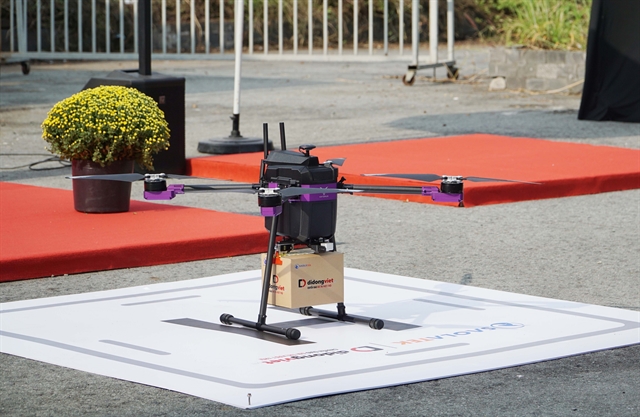 Features
Features

The statues of 12 zodiac animals, carved from giant tree stumps found at the bottom of Tiền River, impresses any visitors to Mỹ Luông ecotourism site located in Chợ Mới District in the southern province of An Giang.
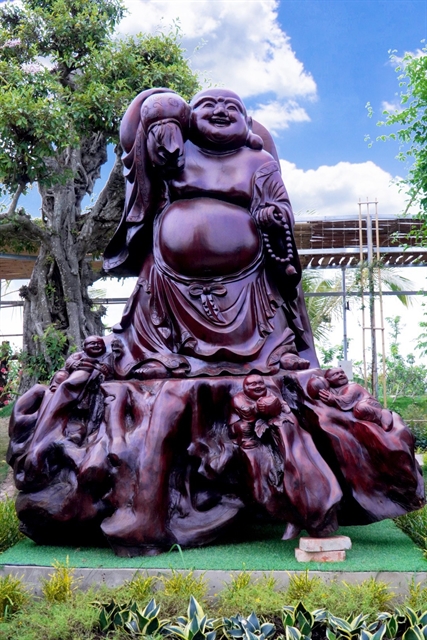
|
| A statue made of driftwood is on display at Mỹ Luông ecotourism site. Photo courtesy of Phan Văn Khánh |
By Lương Hương
The statues of 12 oriental zodiac animals, carved from giant tree stumps found at the bottom of the Tiền River, impresses visitors to Mỹ Luông ecotourism site located in Chợ Mới District in the southern province of An Giang.
The statues are among artworks created from ancient tree stumps that have been collected by local Nguyễn Văn Nghỉ over the past 15 years.
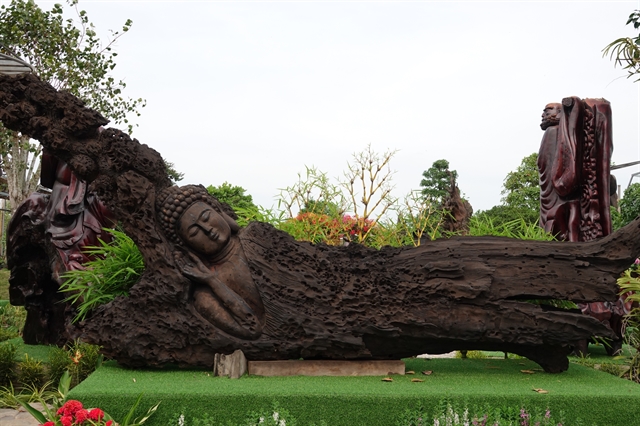
|
| A Reclining Buddha statue made of driftwood is on display at Mỹ Luông ecotourism site. Each artwork could weigh up to five tonnes. Photo courtesy of Phan Văn Khánh |
Other impressive works on display at the site include a Reclining Buddha statue, a statue of President Hồ Chí Minh, a wooden picture, a wooden house and a set of table and chairs, all of which have been meticulously crafted from hundred-year-old driftwood.
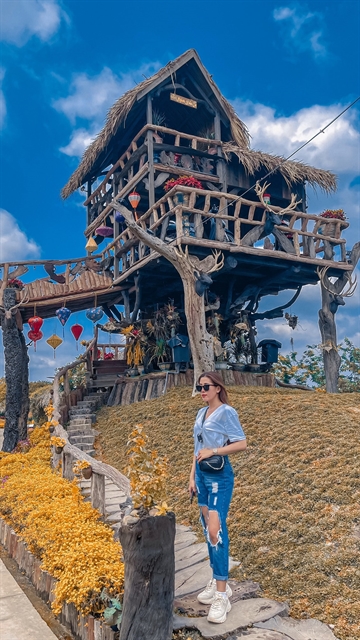
|
| A visitor poses for a photo in front of a wooden house made from driftwood that belongs to Nghỉ's collection. Photo courtesy of Mỹ Luông ecotourism site |
Each work could weigh up to five tonnes and some statues could reach up to eight metres in height.
"Mỹ Luông Town is an ancient carpentry village by the Tiền River, so the love for the traditional craft has been naturally instilled in my blood,” Nghỉ said.
“The river has been crowded with fishing boats. Whenever a boat gets stuck with a tree lying at the bottom of the river, its owner will call me for help because I have a barge and salvage equipment. At first, I just intended to help others and take the stumps as firewood,” the 43-year-old who is working as a constructor said.
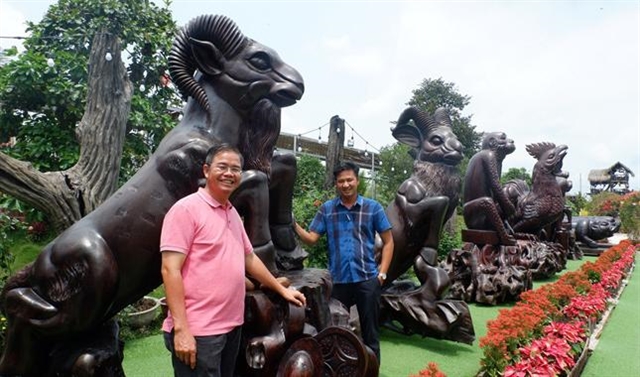
|
| Nghỉ (right) has collected over 3,000m3 of driftwood. Photo courtesy of Phan Văn Khánh |
But the giant tree stumps had been submerged for hundreds of years on the bottom of the river and eroded by the water, leaving only the core as hard as iron so they are unsuitable to be used as firewood.
Time and water erosion has made it difficult to distinguish the types of trees so they are commonly called driftwood.
The driftwood fished out was piled up in the empty land by Én dune between An Giang and Đồng Tháp Province. Gradually, the pile became huge with hundreds of tree stumps.
"At that time the idea of collecting driftwood and turning it into objects and artworks popped up in my mind as I could see that it is not easy to find appropriate pieces for carving.
“Whenever I have free time, I will travel back and forth on the Tiền and even to the nearby Hậu River to ask if anyone saw any pieces of driftwood while on their fishing trips. Strangely, little driftwood is found in Hậu River but there is plenty at the bottom of the Tiền,” the collector said.
After 15 years, Nghĩa now owns over 3,000 cubic metres of driftwood. He has hired skilled craftsmen from the central province of Huế and even as far as the northern province of Nam Định to sculpt the most beautiful pieces of driftwood into 40 works of art.
According to Phan Văn Khánh, director of Mỹ Luông ecotourism site, it takes a lot of time and effort to craft artworks out of driftwood. The petrified wood lying at the river bottom for hundreds of years has become as hard as iron.
Adding to that, the saw blade can become blunt during the carving process, making it difficult to shape the wood. Therefore, it took up to five years to complete the 40 artworks from driftwood.
“Driftwood is mostly parts of huge trees that are several hundred years old. Due to various impacts, the trees were buried in the riverbed for hundreds of years, causing the wood to disintegrate and leaving only the core of the tree as strong and hard as iron and stone.
"Therefore, it is almost impossible to identify the kind of tree that it belongs to, but it also means that the material is extremely durable and unaffected by termites and weather," Khánh said.
According to him, the craftsmen will sculpt the artworks based on the natural shapes of the driftwood.
“The beauty of the driftwood is often hidden so the creator must have a keen eye and imagination to explore it,” he added.
Then the aim to introduce his unique collection to the public inspired him to establish a tourism site in the area which he expects to become a highlight in his hometown.
“I was annoyed at the thought that not many tourists knew about Chợ Mới District, but then I realised that the district indeed has few tourism attractions,” Nghỉ said.
After only nine months, he put a lot of effort into turning his two-hectare land into Mỹ Luông ecotourism site, with total investment of over VNĐ69 billion (US$3 million).
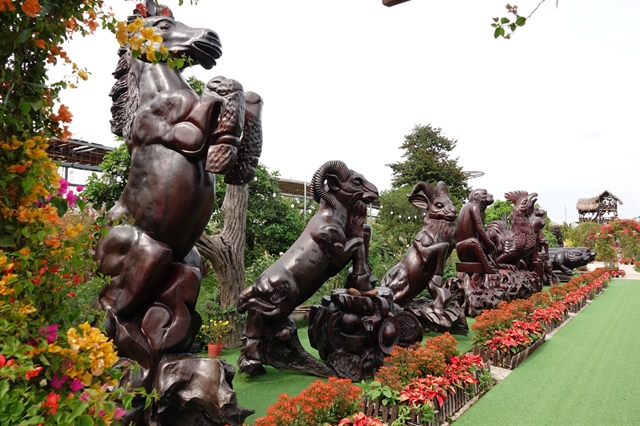
|
| Statues of 12 zodiac animals made of driftwood impress any visitors to Mỹ Luông ecotourism site. Photo courtesy of Phan Văn Khánh |
Opened during the last Lunar New Year festival, the site has become a must-visit destination for tourists to Chợ Mới District and received encouragement from local authorities.
During a visit to the site on March 17, the then National Assembly Chairwoman Nguyễn Thị Kim Ngân highly appreciated the locality's efforts to launch new and original tourism products, creating highlights for tourism development for An Giang and the Mekong Delta as a whole. Thereby, the province is requested to continue to support investors to expand and diversify tourism products.
In the meantime, Nghỉ is working on another piece of vacant land to turn it into a local tourist destination so that “more people will know about Chợ Mới District". VNS

